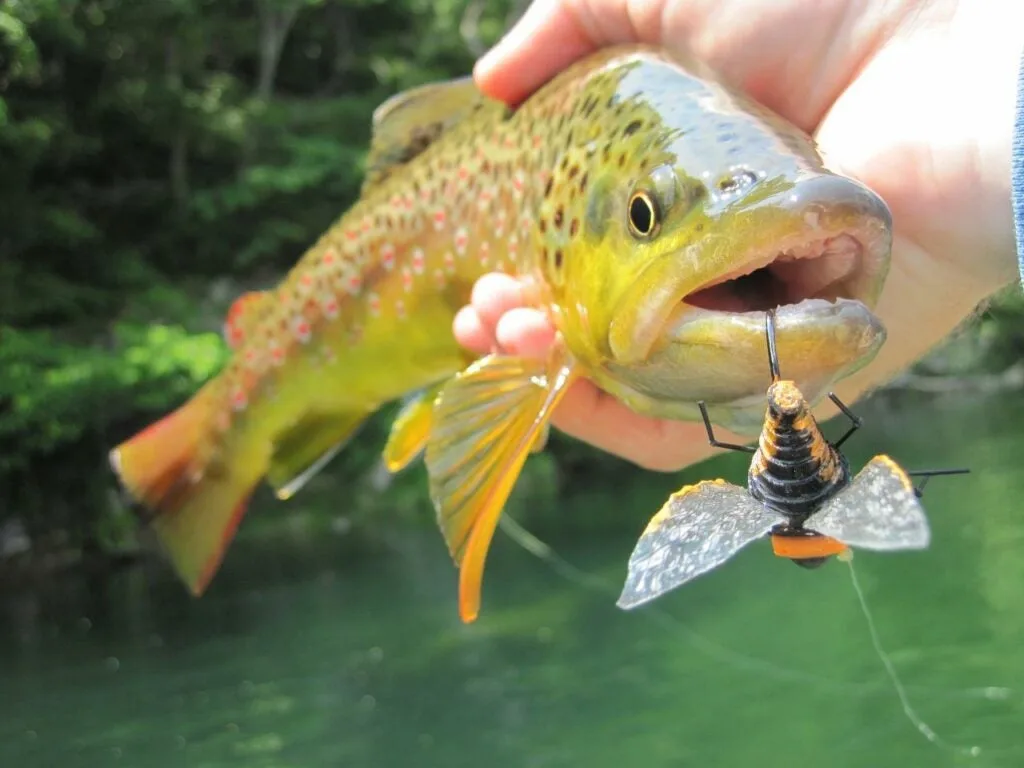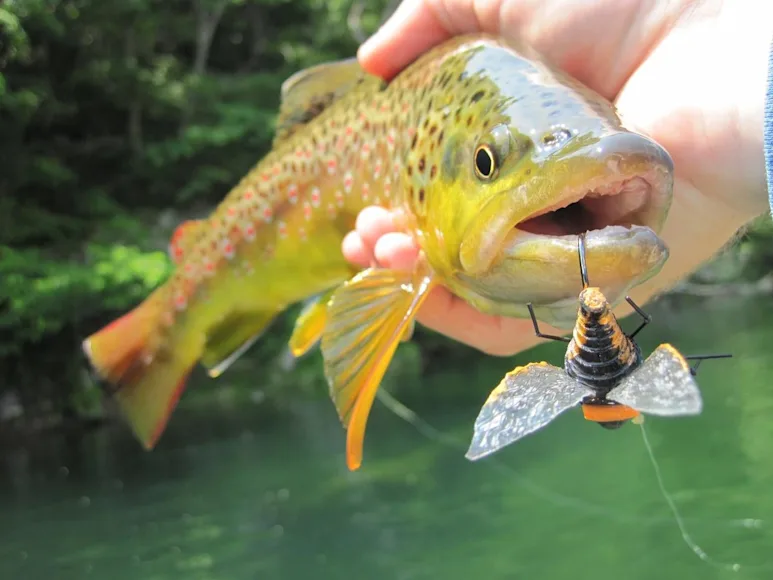_We may earn revenue from the products available on this page and participate in affiliate programs. Learn more ›
_
FLY-FISHERS in the eastern half of the U.S. are eagerly anticipating a hatch 17 years in the making: the Brood X cicada emergence. From around mid-May through June, billions of these chubby bugs will be singing in trees from Georgia to Pennsylvania to Illinois. They don’t belong in the water, but many will end up there anyway, and fish will respond just as you would expect.
You need a heavier leader than the spider web you use for dainty mayfly patterns, but otherwise, fishing cicada patterns is pretty much the same as your every-season beetles, hoppers, and ants. If you’re in an area with a heavy hatch and, importantly, trees near the water, you stand a good chance of having an exciting Brood X experience.

During a cicada hatch, brown trout can’t help but hit a meaty terrestrial pattern. Patrick Fulkrod
“When cicadas hatch, everything eats them,” says guide Patrick Fulkrod, founder of the South Holston River Company in Tennessee. “It’s incredible. As soon as your fly makes a splash on the water, everything will want a piece of it. I’ve had birds diving for them, and I’ve even seen squirrels swimming in the river after them. Also, fish that you’ve never seen eating aggressively on the surface, like carp, stripers, and catfish, will go for cicadas.”
Where Will the 2021 Brood X Cicada Hatch Happen?
The cicadas of Brood X (it’s a Roman numeral; X is one of 12 broods with a 17-year life cycle) were born in 2004 and have spent all these years underground, feeding on tree roots, tunneling around, and biding their time. During their brief six weeks above ground, they will call out for mates with a high-pitched drone often compared to the sound of the invaders in War of the Worlds.
Scientists have identified nearly 3400 species and sub-species of cicada around the world, and the list is growing. The Brood X cicadas are Magicicada septendecim, black and orange with red eyes, with bodies a little over an inch long and wings a bit longer. Based on past emergences, they’re expected in Delaware, Georgia, Illinois, Indiana, Kentucky, Maryland, Michigan, North Carolina, New Jersey, New York, Ohio, Pennsylvania, Tennessee, Virginia, West Virginia, and Washington D.C. They don’t hatch uniformly across the states; it’s quite localized. Fulkrod has told inquiring clients he expects more cicada activity in the Knoxville area, about 100 miles to the west, than in the northeast corner of the state, where he’s based. County-level maps
can be found online.
Tom Baltz is a top-tier fishing guide and writer, but he’s mostly a mayfly guy, and he was caught a little off-guard on a trip to Penn’s Creek in Pennsylvania during the 2004 emergence. “As soon as we opened the car door and stepped out, I knew we were in trouble, because I didn’t have anything like a cicada, and it sounded like there were Martians landing,” he says. The trout, he recalls, “looked like sharks coming up and grabbing seals.”
“They only hit the cicadas that fluttered,” he says. “If they weren’t fluttering, the trout just let them float through.” Baltz put that observation to work when guiding clients on nearby Clark’s Creek: the flat pools were frustrating, but trout in the riffles above were more cooperative. He still didn’t have a cicada pattern per se, but a good-sized hopper took fish in the broken water.
A big part of the fun is the fact that fishing a cicada emergence is mostly a topwater experience. But George Daniel, the guide and author who teaches fly-fishing at Penn State, says that sometimes, trout are more willing to grab a cicada pattern
drifting below the surface than one floating on top. His Sunken Cicada pattern is designed for such days.
5 Tips for Flyfishing a Cicada Hatch
Here are a few things to keep in mind if you want in on the Brood X action:
1. Stick to the Trees
Fish where the bugs are. “One thing you need to have a lot of cicadas is a lot of trees,” Baltz says. Rivers, streams, and still waters bordered by treeless meadows aren’t likely to be much good.
2. Use a Heavy Tippet
You’ll be casting wind-resistant bugs at least an inch long, and might be catching good-sized fish, so use 3x tippet or even heavier.
3. Twitch Your Fly
Try twitching your fly—slightly—to inspire fish to strike in calm water. Be ready to relocate to swifter sections if the pool fish are too fussy.
4. Get Under the Surface
Be willing to fish subsurface. Try George Daniel’s Sunken Cicada
, or pull a topwater pattern underwater with split shot on the leader.
5. Focus on Other Species
Don’t restrict yourself to trout. For example, the cicada hatch is a great opportunity to catch carp at the surface. And anything that will put smallmouth bass on your line is worth doing.
“Don’t overthink it,” Fulkrod says. “You don’t need to be that calculated. These are easy meals for these fish. They’re fighting each other for this food.”

This spring, the skies in many states will be filled with cicadas. CicadaMania.com
Brood X Cicada Mania Has Started Already
After the 2004 hatch, Baltz eventually did tie up a few deer-hair cicada patterns
. But he hasn’t had occasion to use them yet. He enjoys seeing so many anglers excited about cicadas, especially at a time when so many other activities have been restricted.
“Everybody’s all pumped about it, and right now, that can’t be a bad thing,” he says. “People are tying flies, and they’re buying stuff in fly shops. I’m gonna get that little box out from 17 years ago and stick it in my vest in case I bump into cicadas with clients.”
When Will the Next Cicada Hatch Happen?
If Brood X doesn’t work out for you this time around, don’t despair. Brood XIV, another 17-year event, is expected to bring cicadas to most of the same states, plus Massachusetts and North Carolina, in 2025. Meanwhile, anglers from Oklahoma to Georgia and up into Illinois and Indiana can look forward to Brood XIX, a 13-year emergence, in 2024. There are also sometimes “straggler” events, like the Brood X cicadas that emerged in 2017, and many places have at least a few annual cicadas. Visit cicadamania.com
for more.
_This story originally ran in the Great Escapes
issue of_ Field & Stream_. Read more F&S+
stories._






